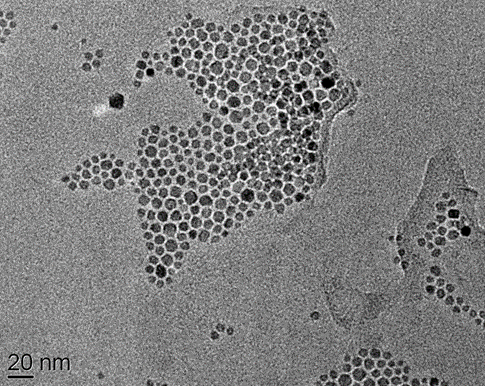Functionalised nanoparticles

Inorganic nanoparticles attracted a lot of scientific interest in the past years - mainly due to the large differences in electronic and surface properties in comparison to macroscopic materials. These characteristics render them as ideal building blocks for new functional materials with outstanding properties.
Our group works on the surface functionalisation of inorganic nanoparticles and their incorporation in organic and inorganic polymers utilising various synthetic strategies. The major challenges in the synthesis of nanocomposites are on the one hand the surface functionalisation of the particles in order to maintain a stable connection to the organic matrix and on the other hand, the nanoparticles should be dispersed homogenously in the organic matrix.
We follow two distinct routes to reach this aim: The functionalisation of previously synthesised particles and the in situ functionalisation of nanoparticles during their preparation. For both methods the surface coverage with molecules carrying an anchor group as well as additional functional groups maintaining compatibility with the polymer matrix is mandatory. Typical anchor groups are trialkoxysilanes, phosphonates, sulfonates or other groups with the ability of coordinating towards the particle surface. Of special interest in this context are the binding mechanisms of these functional groups to the particle surface and their influence on the physical properties of the resulting functionalised nanoparticles. Which anchor group is used depends on the further processing of the particles. The surface functionalised particles can thus be used as crosslinkers or initiators in polymerisation reactions. The freedom of choosing the appropriate inorganic key component and modifying the surfaces in different ways facilitates the preparation of a large variety of materials.
The inorganic particles we mainly use are metal oxides which are prepared by precipitation reactions, hydrothermal thechniques, the sol-gel process, microemulsion techniques or continuous methods. Current research topics are the production of nanoparticles by continuous syntheses, anisotropic surface functionalisation and the production of particles from silicones.
Book Chapters:
Core-Shell Nanoparticles. G. Kickelbick, L. M. Liz-Marzan, in Encyclopedia of Nanoscience and Nanotechnology, Edited by H. S. Nalwa, American Scientific Publishers, Los Angeles, 2004, Vol. 2, pp. 199.
Nanoparticles and Composites, G. Kickelbick in The Sol-Gel Handbook - Synthesis, Characterization, and Applications, (3-Volume Set), (Eds. D. Levy, M. Zayat) Wiley-VCH, 2015, Weinheim, Germany, pp 227-239.
Reviews:
Janus Particles: Anisotropy as a function, Mueller, Nina; Heinrich, Charlotte; Abersfelder, Kai; Kickelbick, Guido, Chemie in Unserer Zeit 2016, 50(6), 392-399. doi:10.1002/ciuz.201600730
Selected Scientific Papers:
- Additive-free continuous synthesis of silica and ORMOSIL micro- and nanoparticles applying a microjet reactor, C. Odenwald, G. Kickelbick, J. Sol-Gel Sci. Technol. 2019, 89, 343-353. doi:10.1007/s10971-018-4626-x
- Surface-charged zirconia nanoparticles prepared by organophosphorus surface functionalization with ammonium or sulfonate groups, C. Heinrich, L. Niedner, B. Oberhausen, G. Kickelbick, Langmuir 2019, 35, 11369-11379. doi:10.1021/acs.langmuir.9b01093
- Facile and scalable synthesis of sub-micrometer electrolyte particles for solid acid fuel cells, F. P. Lohmann-Richters, C. Odenwald, G. Kickelbick, B. Abel, A. Varga, RSC Adv. 2018, 8, 21806-21815.doi:10.1039/C8RA03293A
- Local Effects on Airway Inflammation and Systemic Uptake of 5 nm PEGylated and Citrated Gold Nanoparticles in Asthmatic Mice; A. J. Omlor, D.D. Le, J. Schlicker, M. Hannig, R. Ewen, S. Heck, C. Herr, A. Kraegeloh, C. Hein, R. Kautenburger, G. Kickelbick, R. Bals, J. Nguyen, D. Q. Thai; Small 2017, 13, 1603070. doi:10.1002/smll.201603070
- Bottom-up, Wet Chemical Technique for the Continuous Synthesis of Inorganic Nanoparticles; A. Betke, G. Kickelbick; Inorganics, 2014, 2, 1-15. doi: 10.3390/inorganics2010001
- Synthesis and aggregation behavior of hybrid amphiphilic titania Janus nanoparticles via surface-functionalization in Pickering emulsions; N. Zahn, G. Kickelbick; Colloids and Surfaces, A: Physicochemical and Engineering Aspects2014, 461, 142-150. doi:10.1016/j.colsurfa.2014.07.039
